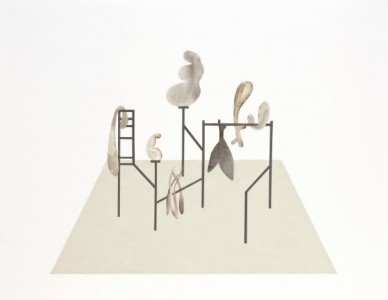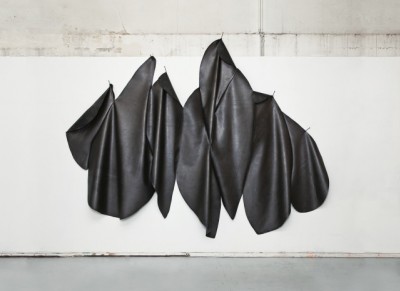A Paradoxical Nature
by Gaelle Porte, May 2015
Mathilde Roussel gives life to her artworks through a conscientious exploration of mediums. She merges contrasting materials together such as delicate paper-pulp, supple wire and sturdy metal beams. Her humble nature is reflected in the process as the artist lets the artwork morph autonomously — taking on a new manifestation of its own under the sole rule of gravity. Like a pragmatic scientist, she observes her experiments, analyzing how the interactions she imposes result. Some tests are a success and live on. Others fail and will be recycled.
Recycling is a key element to Roussel’s work. Having grown up surrounded by nature in the French countryside, she accepted early on the harsh reality of the cycle of life and its food chain. Everything has an end, which serves other living beings for their survival. This idea is expressed by the father of modern chemistry Antoine Lavoisier as “Nothing is lost, nothing is created, everything is transformed.” Hence, Roussel easily “lets go” and allows her creations to evolve in their newly given form. For instance, she will turn discarded preparatory drawings into paper pulp. This results in an emulation of flesh that serves to cover her large limb-like Training Session sculptures that balance on metal beams, at the edge of life.
Staged as a human scale mobile the audience can walk through, these Training Session installations convey a strong sense of opposition between the gruesome and the joy in Roussel’s work. She triggers imagination and playfully suggests innocent acrobats in a circus contrasted to a morbid butcher refrigeration room. It is in the paradox of life and death that Roussel extracts the beauty of her artworks.
While examining body building books to mold her shapes, Roussel takes interest in humankind’s fascination for physical perfectionment: Transhumanism. In the 19th century, Darwin observed the natural evolution in species to become more performant, but today our new technologies allow us to force nature, bending its course to our pleasing. We now impose permanent changes to our bodies, thanks to science, to follow trends such as nose reductions or breast enlargements. When looking at Roussel’s works, it is unclear whether she is critical of this aspect of contemporary Pop culture, or just amused. This ambiguity emphasizes the constant sense of contrast in her oeuvre. She further subtly alludes to our cult of the body by adding flavored manmade protein mix as a color dye for her pieces. Yet, Roussel’s works always maintain a pure and natural essence through the organic materials and shapes she uses.
Her works on paper often resemble cells, plants or muscles, and the larger rubber pieces Peau recall skin, as their French title indicates. Most of her mediums of choice display a porous quality that conveys the notion of ephemerality. Her 25.08.79 early sculptures of human figures in dirt are not meant to last. They float in the air as the wheat seeds she planted grow and eventually, die. We are mortal, though our society fights it. Roussel seems to accept this reality by introducing artificial materials such as silicon and cement in her more recent works to strengthen them. She also pushes the limits of paper by incising it until it nearly tears, yet it perdures, hanging there, resistant.
As she explains in her artist statement “I seek to capture temporalities that inhabit and mark our corporeality: aging, hardening, sagging, scarring, mutation. This research consists in producing shapes and materials of a delicate nature to express our vulnerability.” The aging can be observed on the Training Session and Peau sculptures in particular in the way the material dehydrates over time and cracks, just as skin does on a human body, creating wrinkles. It is interesting to relate the aging process to the overall body of her work as she progressively departs from a clear figurative visual and ventures towards a more abstract interpretation of life.
Roussel introduces layering in more and more of her works to show the passage of time. The overlapping of materials evoke pretrifications that take place in caves over years as the dripping sediment deposits evolve into growing shapes. In the same way, the calcification in our bodies can lead to arthritic malformations, disfiguring its victim. The thick coating of materials becomes a protective shell, fossilizing the initial shape and creating a mystery over what that work once was. Roussel feels a strong correlation between her process and the Italian classical sculptures placed in artificial caves in the 16th century to be gradually covered by rock formations as described in Philippe Morel’s Les Grottes maniéristes en Italie au XVIème siècle. Théâtre et alchimie de la nature.
Agilely walking the thin line between life and death, the artificial and the natural, Roussel has found the balance of life. Filled with memories, her works have built a carapace through experience to overcome the hard reality of the world.
by Gaelle Porte, May 2015
Mathilde Roussel gives life to her artworks through a conscientious exploration of mediums. She merges contrasting materials together such as delicate paper-pulp, supple wire and sturdy metal beams. Her humble nature is reflected in the process as the artist lets the artwork morph autonomously — taking on a new manifestation of its own under the sole rule of gravity. Like a pragmatic scientist, she observes her experiments, analyzing how the interactions she imposes result. Some tests are a success and live on. Others fail and will be recycled.
Recycling is a key element to Roussel’s work. Having grown up surrounded by nature in the French countryside, she accepted early on the harsh reality of the cycle of life and its food chain. Everything has an end, which serves other living beings for their survival. This idea is expressed by the father of modern chemistry Antoine Lavoisier as “Nothing is lost, nothing is created, everything is transformed.” Hence, Roussel easily “lets go” and allows her creations to evolve in their newly given form. For instance, she will turn discarded preparatory drawings into paper pulp. This results in an emulation of flesh that serves to cover her large limb-like Training Session sculptures that balance on metal beams, at the edge of life.
Staged as a human scale mobile the audience can walk through, these Training Session installations convey a strong sense of opposition between the gruesome and the joy in Roussel’s work. She triggers imagination and playfully suggests innocent acrobats in a circus contrasted to a morbid butcher refrigeration room. It is in the paradox of life and death that Roussel extracts the beauty of her artworks.
While examining body building books to mold her shapes, Roussel takes interest in humankind’s fascination for physical perfectionment: Transhumanism. In the 19th century, Darwin observed the natural evolution in species to become more performant, but today our new technologies allow us to force nature, bending its course to our pleasing. We now impose permanent changes to our bodies, thanks to science, to follow trends such as nose reductions or breast enlargements. When looking at Roussel’s works, it is unclear whether she is critical of this aspect of contemporary Pop culture, or just amused. This ambiguity emphasizes the constant sense of contrast in her oeuvre. She further subtly alludes to our cult of the body by adding flavored manmade protein mix as a color dye for her pieces. Yet, Roussel’s works always maintain a pure and natural essence through the organic materials and shapes she uses.
Her works on paper often resemble cells, plants or muscles, and the larger rubber pieces Peau recall skin, as their French title indicates. Most of her mediums of choice display a porous quality that conveys the notion of ephemerality. Her 25.08.79 early sculptures of human figures in dirt are not meant to last. They float in the air as the wheat seeds she planted grow and eventually, die. We are mortal, though our society fights it. Roussel seems to accept this reality by introducing artificial materials such as silicon and cement in her more recent works to strengthen them. She also pushes the limits of paper by incising it until it nearly tears, yet it perdures, hanging there, resistant.
As she explains in her artist statement “I seek to capture temporalities that inhabit and mark our corporeality: aging, hardening, sagging, scarring, mutation. This research consists in producing shapes and materials of a delicate nature to express our vulnerability.” The aging can be observed on the Training Session and Peau sculptures in particular in the way the material dehydrates over time and cracks, just as skin does on a human body, creating wrinkles. It is interesting to relate the aging process to the overall body of her work as she progressively departs from a clear figurative visual and ventures towards a more abstract interpretation of life.
Roussel introduces layering in more and more of her works to show the passage of time. The overlapping of materials evoke pretrifications that take place in caves over years as the dripping sediment deposits evolve into growing shapes. In the same way, the calcification in our bodies can lead to arthritic malformations, disfiguring its victim. The thick coating of materials becomes a protective shell, fossilizing the initial shape and creating a mystery over what that work once was. Roussel feels a strong correlation between her process and the Italian classical sculptures placed in artificial caves in the 16th century to be gradually covered by rock formations as described in Philippe Morel’s Les Grottes maniéristes en Italie au XVIème siècle. Théâtre et alchimie de la nature.
Agilely walking the thin line between life and death, the artificial and the natural, Roussel has found the balance of life. Filled with memories, her works have built a carapace through experience to overcome the hard reality of the world.





